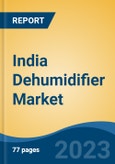Speak directly to the analyst to clarify any post sales queries you may have.
10% Free customizationThis report comes with 10% free customization, enabling you to add data that meets your specific business needs.
Key Market Drivers
Growing Awareness of Indoor Air Quality and Health Concerns
The rising concern over air quality and its direct impact on human health is a key driver of the India dehumidifier market. In urban and semi-urban environments, where pollution and particulate matter levels often breach safety thresholds, households and institutions are increasingly seeking ways to maintain healthier indoor conditions. As of 2024, among 253 Indian cities with adequate PM10 monitoring, 206 exceeded the permissible limits set by the National Ambient Air Quality Standards (NAAQS). High indoor humidity levels can contribute to mold, mildew, and allergen accumulation - posing health risks such as asthma and respiratory irritation. Growing consumer education around these risks is prompting a surge in dehumidifier adoption in homes, offices, hospitals, and educational institutions. The heightened emphasis on health and hygiene following the COVID-19 pandemic has also played a significant role in encouraging consumers to invest in air quality control solutions, including dehumidifiers.Key Market Challenges
High Initial Cost and Affordability Issues
A major obstacle to widespread adoption of dehumidifiers in India is their relatively high upfront cost. Advanced models featuring smart controls, digital interfaces, and energy-saving compressors are often priced beyond the reach of many consumers in rural or lower-income urban areas. The financial barrier is especially pronounced when compared to more essential household appliances.Despite the long-term benefits of dehumidifiers - such as improved health outcomes and reduced maintenance costs associated with humidity damage - many consumers remain hesitant due to the initial investment. This has resulted in limited market penetration beyond higher-income urban segments. Additionally, the market's price-sensitive nature forces brands to balance performance and affordability, which may affect product durability or effectiveness in budget variants. The absence of financing schemes or subsidies for air quality improvement appliances further compounds the issue, slowing mass adoption.
Key Market Trends
Integration of Smart Technology and IoT Features
An emerging trend in the India dehumidifier market is the growing incorporation of smart technology and IoT features into product lines. With urban consumers increasingly embracing smart home ecosystems, dehumidifiers equipped with Wi-Fi connectivity, mobile app controls, and real-time humidity monitoring are gaining popularity. Features like automated moisture level adjustment, voice assistant integration (e.g., Alexa, Google Assistant), and energy consumption analytics enhance convenience and user control. These advancements cater to digitally literate, tech-savvy customers, especially in metropolitan regions. As India’s digital infrastructure matures and the appetite for connected devices grows, manufacturers are investing in IoT-enabled dehumidifiers to remain competitive. These smart solutions not only improve user experience but also support energy efficiency and preventative maintenance, aligning with consumer expectations for value and functionality.Key Market Players
- Bry-Air (Asia) Pvt. Ltd.
- Swastik Refrigeration
- Amfah India Trading Pvt. Ltd.
- Honeywell India Private Limited
- Ahata Industries
- Dewdry Engineers Pvt Ltd
- Drytech Industries
- Powerpye Electronics
- Condair Group AG
- Drycool Systems India (Pvt.) Ltd
Report Scope:
In this report, the India Dehumidifier Market has been segmented into the following categories, in addition to the industry trends which have also been detailed below:India Dehumidifier Market, By Product Type:
- Desiccant
- Refrigerant
India Dehumidifier Market, By Coverage Area:
- Less Than 1000 sq. ft
- 1000-2000 sq. ft
- More Than 2000 sq. ft
India Dehumidifier Market, By Distribution Channel:
- Online
- Offline
India Dehumidifier Market, By Region:
- North
- South
- East
- West
Competitive Landscape
Company Profiles: Detailed analysis of the major companies present in the India Dehumidifier Market.Available Customizations:
With the given market data, the publisher offers customizations according to a company's specific needs. The following customization options are available for the report.Company Information
- Detailed analysis and profiling of additional market players (up to five).
This product will be delivered within 1-3 business days.
Table of Contents
Companies Mentioned
- Bry-Air (Asia) Pvt. Ltd.
- Swastik Refrigeration
- Amfah India Trading Pvt. Ltd.
- Honeywell India Private Limited
- Ahata Industries
- Dewdry Engineers Pvt Ltd
- Drytech Industries
- Powerpye Electronics
- Condair Group AG
- Drycool Systems India (Pvt.) Ltd
Table Information
| Report Attribute | Details |
|---|---|
| No. of Pages | 80 |
| Published | July 2025 |
| Forecast Period | 2024 - 2030 |
| Estimated Market Value ( USD | $ 178.69 Million |
| Forecasted Market Value ( USD | $ 264.8 Million |
| Compound Annual Growth Rate | 6.7% |
| Regions Covered | India |
| No. of Companies Mentioned | 10 |









